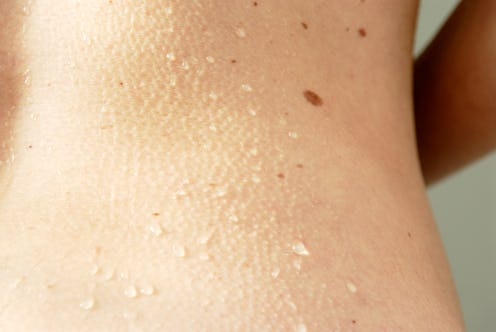Wellness
An Expert Explains How Your Brain Flips Out When You Get Goosebumps
Spooky, scary.

A haunted house, a cool night, an intense piece of music: all of them can make goosebumps sweep across your skin, making your hair stand on end. When you get an attack of goosebumps, otherwise known as gooseflesh or goose pimples, the muscles around each hair follicle contract, raising them up into little bumps. But while they might seem like little lumps with lives of their own, goosebumps have an intriguing connection with your brain.
When your brain detects something scary, it triggers the amygdala, a brain area dedicated to interpreting threats. The amygdala activates another brain area called the hypothalamus, which prompts a surge of adrenaline, a hormone that kicks off your fight or flight reflex. And when that surge happens, goosebumps, known as the pilomotor reflex, often follow. (This is why you may experience waves of goosebumps during a panic attack: the brain is pumping adrenaline, and your pilomotor reflex is going wild in response.)
The pilomotor reflex is the same reaction that means your cat's hair stands on end when it's scared: adrenaline makes its hair prick up to make it seem bigger and more imposing to its foes. Humans aren't covered in hair any more, but goosebumps — also called, ahem, piloerection — are a hangover from our hairier days. Goosebumps may have stuck around for another reason: too. A study published in Cell in 2020 found that the cells that cause goosebumps by contracting muscles are also important for the health of the hair follicle around them. Without those cells, the hair might actually fall out.
Goosebumps can also prompted by cold. When you're freezing or in the grip of chills during a fever, adrenaline kicks in to try and warm us up by fluffing up body hair — but our fur has long gone, so now it's just a prompt to put on a warmer coat.
Non-physical things can also spike your adrenaline levels: a beautiful speech, a loud bang, a breath on the back of your neck. Emotional goosebumps might seem odd, but really strong emotional responses can create all kinds of bodily changes, like sweating and crying. A study of emotional piloerection, as it's called, in Biological Psychology in 2011 found that many people experience emotional goosebumps in reaction to music, particularly film soundtracks, familiar tunes, and songs that spark a mix of fear and joy.
"There are a number of different theories for why people experience goosebumps (or chills more broadly) to music," neuroscientist Matthew Sachs Ph.D., a researcher of goosebumps, tells Bustle. One theory suggests you get chills when your expectation of the music is challenged — a new instrument comes in, it gets louder, or the rhythm alters. "This leads to an initial, immediate surprise or fear response," he says. Once you realize that the music isn't a threat, though, you start to enjoy it more.
Sachs says that about 90% of the population might experience musical goosebumps, but some never get a quiver. "Certain personality traits have found to be linked to the frequency and likelihood of experiencing chills," he says. The major one, he says, is a trait called openness to experience. "This relates to seeking out new and unfamiliar situations, imagination, intellectual curiosity, and attentiveness to inner feelings."
A study published in PeerJ in 2018 found that some people can give themselves goosebumps on purpose, probably through triggering small adrenaline rushes, but most of us are at the mercy of these tiny little follicles. Whenever you get goose pimples, it's not actually somebody walking over your grave, as my granny used to say; it's a little uptick in stress as your brain tries to keep you safe.
Expert:
Matthew Sachs Ph.D.
Studies cited:
Benedek, M., & Kaernbach, C. (2011). Physiological correlates and emotional specificity of human piloerection. Biological psychology, 86(3), 320–329. https://doi.org/10.1016/j.biopsycho.2010.12.012
Heathers, J., Fayn, K., Silvia, P. J., Tiliopoulos, N., & Goodwin, M. S. (2018). The voluntary control of piloerection. PeerJ, 6, e5292. https://doi.org/10.7717/peerj.5292
McCrae, R. R. (2007). Aesthetic chills as a universal marker of openness to experience. Motivation and Emotion, 31(1), 5–11. https://doi.org/10.1007/s11031-007-9053-1
Sachs, M. E., Ellis, R. J., Schlaug, G., & Loui, P. (2016). Brain connectivity reflects human aesthetic responses to music. Social cognitive and affective neuroscience, 11(6), 884–891. https://doi.org/10.1093/scan/nsw009
Shwartz, Y., Gonzalez-Celeiro, M., Chen, C. L., Pasolli, H. A., Sheu, S. H., Fan, S. M., Shamsi, F., Assaad, S., Lin, E. T., Zhang, B., Tsai, P. C., He, M., Tseng, Y. H., Lin, S. J., & Hsu, Y. C. (2020). Cell Types Promoting Goosebumps Form a Niche to Regulate Hair Follicle Stem Cells. Cell, S0092-8674(20)30808-4. Advance online publication. https://doi.org/10.1016/j.cell.2020.06.031